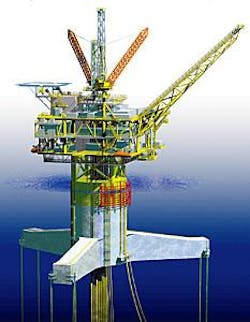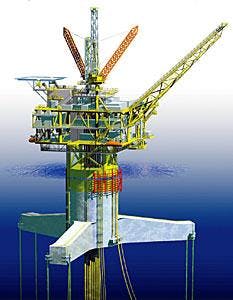Fourth monocolumn TLP planned for deepwater US gulf
The Matterhorn deepwater development project will be the fourth in the Gulf of Mexico to include a monocolumn tension-leg platform (TLP), often referred to as a mini-TLP (Fig. 1).
TotalFinaElf E&P USA Inc. is the operator of the field in Mississippi Canyon Block 243. The TLP will be installed in 2,835 ft of water.
Atlantia Offshore Ltd., Houston, (a unit of IHC Caland NV, Schiedam, The Netherlands) plans to deliver the TLP for installation in summer 2003 under a $175 million lump-sum turnkey contract for the hull, piles, tendons, deck, and topsides.
Subcontractors
Paragon Engineering Services Inc., Houston, is subcontractor for the facilities design-engineering for Matterhorn and says the project is on schedule. It expects to complete its core work for detailed engineering in mid-September 2002.
Atlantia Offshore awarded Gulf Marine Fabricators, Aransas Pass, Tex., the contract for fabricating the TLPs topsides facility and foundation piles. Gulf Marine Fabricators is a unit of the Technip-Coflexip Group.
Gulf Marine Fabricators' work scope includes:
Procurement, fabrication, and outfitting of the 6,000-ton topsides, having an 18.9-m height and a 5,900 sq m area.
Fabrication of six, 96-in. diameter, 415-ft long piles, weighing a total of 2,100 tons.
Gulf Marine Fabricators expects to complete the topsides work by May 2003.
Another Atlantia Offshore subcontractor is Keppel FELS Ltd., Singapore. It received a $22 million contract to build the TLP hull.
The 84-ft diameter hull is under construction at the Pioneer yard in Singapore. The hull consists of a central moonpool and a Y-shaped base pontoon for attachment of the mooring tendons. Keppel FELS expects to complete the hull by yearend 2002.
Monocolumn TLPs
The Matterhorn TLP is Atlantia Offshore's first dry-tree TLP, and the fourth TLP using its SeaStar monocolumn TLP design. The Matterhorn TLP can support up to nine surface trees as well as future subsea well tie-backs. The previous three TLPs handle production from subsea wells and tie-backs from other fields.
The Matterhorn TLP will accommodate workover-completion operations and production of 33,000 bo/d and 55 MMscfd. Atlantia expects the facility's dry weight to exceed 3,000 tons upon completion with a total topsides weight of 6,000 tons.
Atlantia Offshore's first SeaStar monocolumn TLP was installed in 1998 on the Morpeth field in 1,700 ft of water. The second one, in 1999, went on the Allegheny field in 3,280 ft of water. ENI SPA's Agip Petroleum Co. is the current operator for both the Morpeth and Allegheny fields.
ChevronTexaco Corp. operates the third monocolumn TLP, installed in 2,200 ft in of water on the Typhoon field in 2001.
The Typhoon TLP has a production design capacity of 40,000 bo/d and 60 MMscfd from four subsea completed wells.
Design engineering
Paragon says design-engineering for Matterhorn will requires about 60,000 man-hr.
For the facility design, Paragon uses the 3D Plant Design Management System (PDMS) and has included such technical innovations as unique grid design for a pipe rack support system that facilitates the schedule and pipe installation. Paragon's piping group designed the pipe racks with a flexible grid design under each of the three main decks with pre-planned zones for piping and cable tray interconnects.
To remain on target with the deliverables, Paragon and Atlantia Offshore release piping isometrics for fabrication on a phased basis, upon receipt of vendor data. They claim this approach helps facilitate the early release of piping and other interconnects through multiple interface points, such as video-conferencing with the fabrication yard on a weekly basis.
A project challenge for Paragon on Matterhorn, says Stan Hoggatt, Paragon project engineer, has been designing topside equipment, piping, and interconnects for very congested areas, due to the facility's limited clearance between each of its three decks and the subcellar deck.
In the design, Atlantia Offshore strives to keep the vertical center of gravity as low as possible to maximize platform payload capacity. The deck levels have a separation of 25 ft with 4-ft deep girders, leaving up to 21 ft for equipment, cable trays, pipe racks, etc.
As with other floater projects, Paragon observes Title 46 of the Code Federal Regulations (CFRs) under the US Department of Transportation in its engineering-design of the topside facilities. This federal document governs shipping and criteria that pertain to vessel construction, including mobile offshore drilling and production units.
Paragon's work has included constant interface with ABS. It also complies with safety at sea regulations and prepares documents for ABS, which acts on behalf of the US Coast Guard in the review process.
Matterhorn pipelines
In another phase of the work, TotalFinaElf E&P USA, Inc. and Chevron Pipe Line Co. awarded Technip Offshore Contractors Inc. the contract for installing the export pipelines from the TLP to existing pipelines in the area.
The pipelines include two 15.8- miles long 8-in. and 10-in. rigid lines and an associated reeled steel catenary riser.
Technip plans to install the rigid pipe with its CSO Deep Blue vessel in the fourth quarter 2002.

